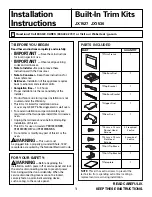
Merlin CH4CO
User Guide
Rev: 07 05-19
4
2
Carbon Monoxide (CO) – General Information
Carbon monoxide (CO) is a poisonous, colourless, odourless, and tasteless gas. Although it has
no detectable odour, CO is often mixed with other gases that do have an odour. So, you can
inhale carbon monoxide right along with gases that you can smell and not be aware that CO
is present.
SYMPTOMS OF CARBON MONOXIDE POISONING
The following symptoms are related to CO poisoning and should be discussed with ALL
members of the household or person/s frequenting monitored areas.
Mild Exposure:
Slight headache, nausea, vomiting, fatigue, flu-like symptoms.
Medium Exposure:
Severe headache, drowsiness, confusion, increased heart rate.
Extreme Exposure:
Unconsciousness, convulsions, cardio-respiratory failure, death.
If you experience even mild symptoms of CO exposure – consult your doctor immediately.
CARBON MONOXIDE PPM LEVELS
This device is equipped with a digital display that shows levels of CO (displayed in PPM: parts
per million).
Dangerous levels:
Generally above 100ppm. This should be treated as an urgent situation.
Medium levels:
Generally between 50ppm to 100ppm. This should be cause for concern and should not be
ignored or dismissed.
Low levels:
Maximum acceptable indoor level of CO is <9ppm.
Anything above this level may cause possible health effects with long-term exposure.
POSSIBLE SOURCES OF CARBON MONOXIDE
Inside your home, appliances used for heating and cooking are the most likely sources of CO.
Vehicles running in attached garages can also produce dangerous levels of CO.
CO can be produced when burning any fossil fuel, such as gasoline, propane, natural gas, oil
and wood. It can be produced in any fuel burning appliance that is malfunctioning, improperly
installed or insufficiently ventilated.
Automobiles, gas stoves, water heaters, portable fuel burning heaters, fireplaces.
Blocked chimneys or flues, corroded or disconnected vent pipes.
Vehicles and other combustion engines running in open or closed garages.
Burning charcoal or fuel in grills in an enclosed area or near the home.


























